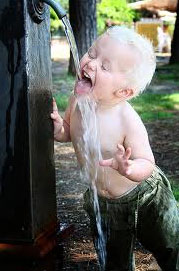 · Water at room temperature is in liquid form. The liquid form of water is a result of small hydrogen atoms and oxygen atoms that strongly pull on these and the hydrogen bonds that are formed between two water molecules.
· Water at room temperature is in liquid form. The liquid form of water is a result of small hydrogen atoms and oxygen atoms that strongly pull on these and the hydrogen bonds that are formed between two water molecules.
· Water molecules are formed by covalent bonds. However, the bond that ties this molecule to another water molecule is the hydrogen bond. Hydrogen bonds are very weak.
· The lifetime of a hydrogen bond is only one in one millionth of a second. However, breaking the bond does not destroy the molecule, because when a bond is broken a new bond is formed immediately. As a result of this constant renewal, it is not possible for water molecules to stick to one another. As a result of this, these molecules become fluid.
· Molecules group together as a mobile liquid instead of a gas, which behaves independently. This unique structure of water is one of the essential elements of life.
· Another result of the weak hydrogen bonds between water molecules is the difference in the density of water’s liquid and solid forms.
· In all all other known forms of matter, solids are denser than liquids; but this is not so for water.
The density of ice, which is the solid form of water, is less than that of water. When water turns into ice, every single molecule that forms ice adheres to its neighbor tightly, due to hydrogen bonds, but the distance between these molecules that form ice is actually very great. Therefore, there are spaces left in between the bonds that form these molecules. The structure of water in solid form thus contains more spaces than its liquid form, and therefore it is less density. As a result of this, when you drop some ice cubes into a glass of water, the ice cubes float.



